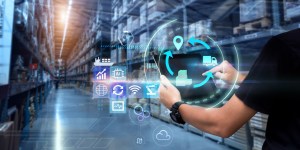If you look closely at Canada’s coat of arms, you’ll see the words “A Mari Usque ad Mare,” which is Latin for “from sea to sea.” It’s a motto that speaks to the breadth of our geography and the culture that spans our country, but it could also describe the aspirations of our national supply chain.
Manufacturers, logistics firms and Canadian businesses all need to be able to get products “from to sea to sea,” whether it’s a customer in Victoria, B.C. or in St. John’s, Newfoundland. For many firms, the supply chain extends far beyond Canada’s borders, to a slew of international suppliers, partners and customers.
Moving goods across the country and globally comes with considerable complexity, in part because of how varied all the players are. At any given moment, for example, an automotive manufacturer might be trying to bring in parts to produce a fleet of vehicles, while a health-care firm is shipping perishable medications to hospitals with patients in need.
What flows through the supply chain not only has to travel without being damaged, but arrive at the right destination in a timely manner. There are many forces which can make this much more difficult than it sounds, from geopolitical events to weather hazards and more.
Supply chains can also be costly to maintain. This not only includes equipment and vehicles but people. Even when labour market shortages aren’t an issue, manufacturers and other companies are recognizing they need to hire candidates with a more sophisticated set of skills than ever before.
The Canadian government is already playing an active role in addressing supply chain issues. A good example is the recent announcement from the Ministry of Transport of $10 million in funding to eliminate congestion and support commercial movements in critical supply chain touchpoints in Saint John and New Brunswick.
Businesses, meanwhile, need to consider how they can contribute to supply chain modernization through the adoption of advanced technologies. This includes tools that can foster greater collaboration among supply chain stakeholders, as well as solutions that provide greater insight into where goods are at any given moment.
Automation and artificial intelligence (AI), for example, open up opportunities to transform many supply chain processes and achieve gains in productivity, efficiency and cost optimization, including:
Streamlining the process of supply chain data ingestion
Before manufacturers and other supply chain stakeholders can improve the flow of goods, they’ll need to put data in systems to analyze it. That’s difficult when data is spread out across many different parts of the supply chain – and when employees have to put it in manually.
Tools to automate data entry could be a first step in helping ingest greater volumes of supply chain data into systems of record that can identify areas for improvement. It also means employees can spend more time on the analysis than merely inputting information.
Increasing visibility with intelligence at the edge
Supply chain management often comes down to a single question: Where are the products? Historically, it wasn’t always easy to know when a crate was taken off a ship and loaded onto a truck, but technology has changed that.
With technologies like the Internet of Things (IoT), for instance, sensors can be fixed directly on equipment to give a clearer view of what’s happening across the supply chain. This enables supply chain partners to track items, and also to get ahead of operational issues. Data about the status of a piece of equipment or part can let companies be more proactive in repairing or replacing parts before they encounter problems, which furthers supply chain resiliency.
Forecasting supply, demand and potential bottlenecks
When data is more accessible and easier to ingest, the real work begins.
Using AI, manufacturers, suppliers and their customers can start to study trends and patterns that could affect what happens along the supply chain.
Modelling these patterns and their potential outcomes can serve a number of purposes. First, it means manufacturers can get a clearer and more accurate sense of customer demand, which means they’ll only order the supplies they need and minimize costly waste.
Second, AI modelling can study supply chain performance to provide early indications of risk. It will help supply chain partners know, for example, where volatile weather might create delays or disruptions as goods are transported from one location to another.
Older technologies took a “rules-based” approach to supply chain automation. The idea was that you could specify that if a particular event took place, equipment and people could pursue a specific action to deal with it. This was undoubtedly helpful, but it fails to take into account all the exceptions and anomalies that business rules might not cover.
AI provides a superior solution because the technology allows businesses to get recommendations based on the specific, unique conditions that might be affecting the supply chain. In some cases they might increase production. In others, they might dispatch more vehicles, or at the very least alert customers that goods won’t be arriving on schedule as expected.
Digitizing business functions for a better customer experience
Although a lot of what happens in the supply chain feels “behind the scenes,” companies should also think about how they can improve the way they indirect on the front lines with customers.
As supply chain operations improve, for instance, everyone from manufacturers and suppliers to retailers benefit from bringing automation and AI to more traditional areas of business. This includes using digital technologies to automate the way they market their brand, sell to customers and provide service and support afterwards.
The potential to transform Canada’s supply chain is broader than the space “from sea to sea.” The opportunity spans everything companies do internally and externally to bring customers the products they want and need.

























